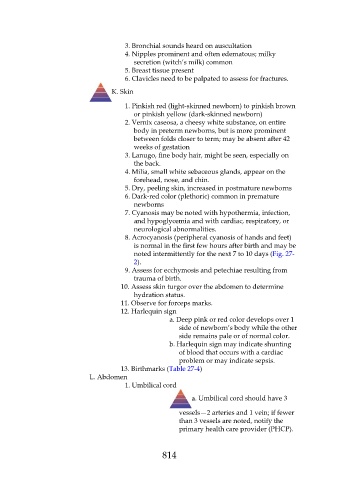Page 814 - Saunders Comprehensive Review For NCLEX-RN
P. 814
3. Bronchial sounds heard on auscultation
4. Nipples prominent and often edematous; milky
secretion (witch’s milk) common
5. Breast tissue present
6. Clavicles need to be palpated to assess for fractures.
K. Skin
1. Pinkish red (light-skinned newborn) to pinkish brown
or pinkish yellow (dark-skinned newborn)
2. Vernix caseosa, a cheesy white substance, on entire
body in preterm newborns, but is more prominent
between folds closer to term; may be absent after 42
weeks of gestation
3. Lanugo, fine body hair, might be seen, especially on
the back.
4. Milia, small white sebaceous glands, appear on the
forehead, nose, and chin.
5. Dry, peeling skin, increased in postmature newborns
6. Dark-red color (plethoric) common in premature
newborns
7. Cyanosis may be noted with hypothermia, infection,
and hypoglycemia and with cardiac, respiratory, or
neurological abnormalities.
8. Acrocyanosis (peripheral cyanosis of hands and feet)
is normal in the first few hours after birth and may be
noted intermittently for the next 7 to 10 days (Fig. 27-
2).
9. Assess for ecchymosis and petechiae resulting from
trauma of birth.
10. Assess skin turgor over the abdomen to determine
hydration status.
11. Observe for forceps marks.
12. Harlequin sign
a. Deep pink or red color develops over 1
side of newborn’s body while the other
side remains pale or of normal color.
b. Harlequin sign may indicate shunting
of blood that occurs with a cardiac
problem or may indicate sepsis.
13. Birthmarks (Table 27-4)
L. Abdomen
1. Umbilical cord
a. Umbilical cord should have 3
vessels—2 arteries and 1 vein; if fewer
than 3 vessels are noted, notify the
primary health care provider (PHCP).
814

